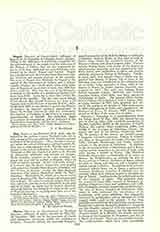

Ibarra, Diocese of (IBARRENSIS), in Northern Ecuador, suffragan of Quito, created by Pius IX, December 29, 1862, out of the provinces of Carchi and Imbabura, previously within the Archdiocese of Quito. Francesco Jabani, the Apostolic Delegate, named as executor of the Bull the Bishop of Antioquia (Colombia), Antonio Riano, at that time in exile at Quito, under whom the canonical erection of the Diocese of Ibarra took place August 6, 1865. For two months Bishop Riano took charge of the diocese as administrator Apostolic, and was succeeded by Jose Maria Jerovi, later Archbishop of Quito, and Arsenio Andrade, afterwards Bishop of Riobamba. Finally, in April, 1867, Jose Ignacio Checa y Barbo was appointed first Bishop of Ibarra, but in June of the following year was transferred to the archiepiscopal see of Quito, being succeeded in June, 1869, in the diocese of Ibarra by Tomas Antonio Iturralde, who resigned in 1875. The next two bishops Pedro Rafael Gonzalez Calixto (1876-93) and Federico Gonzalez Suarez (1895-1906) were later appointed Archbishops of Quito. The present (fifth) incumbent is Ulpiano Perez Quinonez, born August 4, 1863, at Quito, ordained in 1887, later professor and rector of the seminary at Atocha, in 1895 made canon, in 1898 vicar-general of Quito, and appointed to the Bishopric of Ibarra, January 11, 1907, being consecrated on May 19 of the same year at Quito.
Statistics.—According to a communication from the bishop dated May 23, 1907, the diocese has an area of 3661 sq. miles, with a Catholic population of 104,000, including 36,000 in the province of Carchi (Tulcan, the capital, alone comprising 5000), and 68,000 in the province of Imbabura (Ibarra, the capital and seat of the diocese, numbering 5600). The 28 parishes of the diocese are divided among 8 deaneries (vicariatos foraneos): Tulcan, S. Gabriel, and Mira, in the province of Carchi; Otavalo, Cotacachi, Urcuqui, Hatuntaqui, and Ibarra (foraneo central), in the province of Imbabura. In addition to the 55 secular priests, 2 Dominicans and 2 Mercedarians devote themselves to the care of souls, each order having a church at Ibarra. The Discalced Carmelite Sisters have a community of 14 sisters at Ibarra; the Bethlehemites, an academy for girls at Ibarra and one at Tulcan; the Sisters of Mercy, schools for girls at Ibarra and Otavalo and a hospital and orphan asylum at Ibarra. In addition to the primary grammar schools there are at Ibarra a preparatory seminary (Seminario Conciliar S. Didaco) and the national college of S. Alfonso, besides a national college at Tulcan. Candidates for the priesthood study in the seminary at Quito. The cathedral chapter, erected June 18, 1866, consists of 12 canons, including 2 dignitaries (dean and archdean) and 4 officials (theologalis, doctoralis, magistralis, poenitentiarius). The city of Ibarra, founded September 28, 1606, which in 1906 celebrated the tercentenary of its foundation, with great splendor, was repeatedly destroyed by earthquakes, and on the night of 15-August 16, 1868, razed to the ground. It has since partially recovered from the catastrophe, and contains, besides the cathedral, the parish church of S. Augustin and the churches connected with the monasteries of the Dominicans (S. Domingo) and the Mercedarians (Nuestra Senora de la Merced), the church formerly n charge of the Capuchins (S. Francisco), and that of S. Marla del Carmen. There are also 6 public chapels. The confraternities which have been canonically erected at Ibarra include those of the Perpetual Adoration, of the Immaculate Conception (for young ladies), of St. Joseph, of Bl. Maria Ana of Quito. The Third Orders of St. Francis and St. Dominic have members in almost every parish of the diocese.
GREGOR REINHOLD

